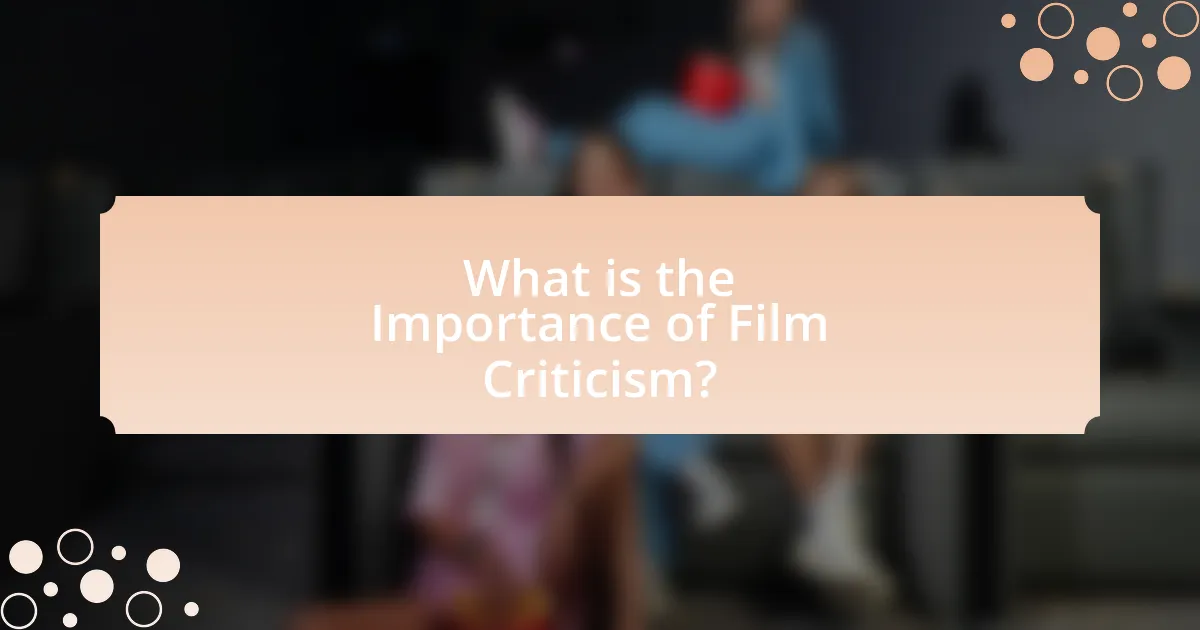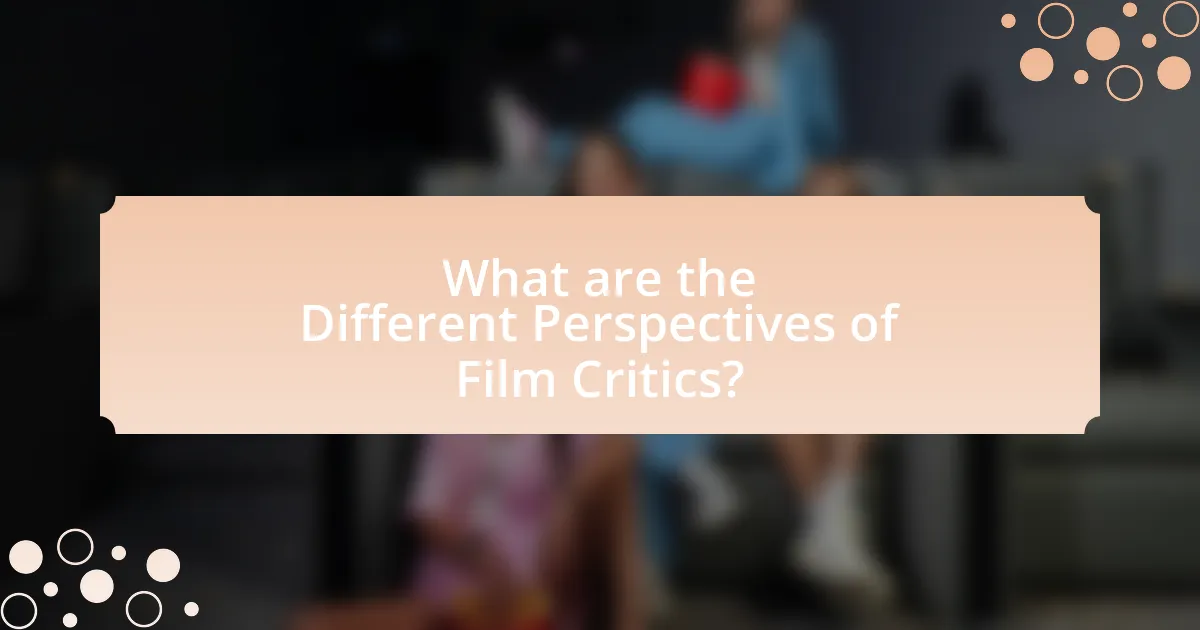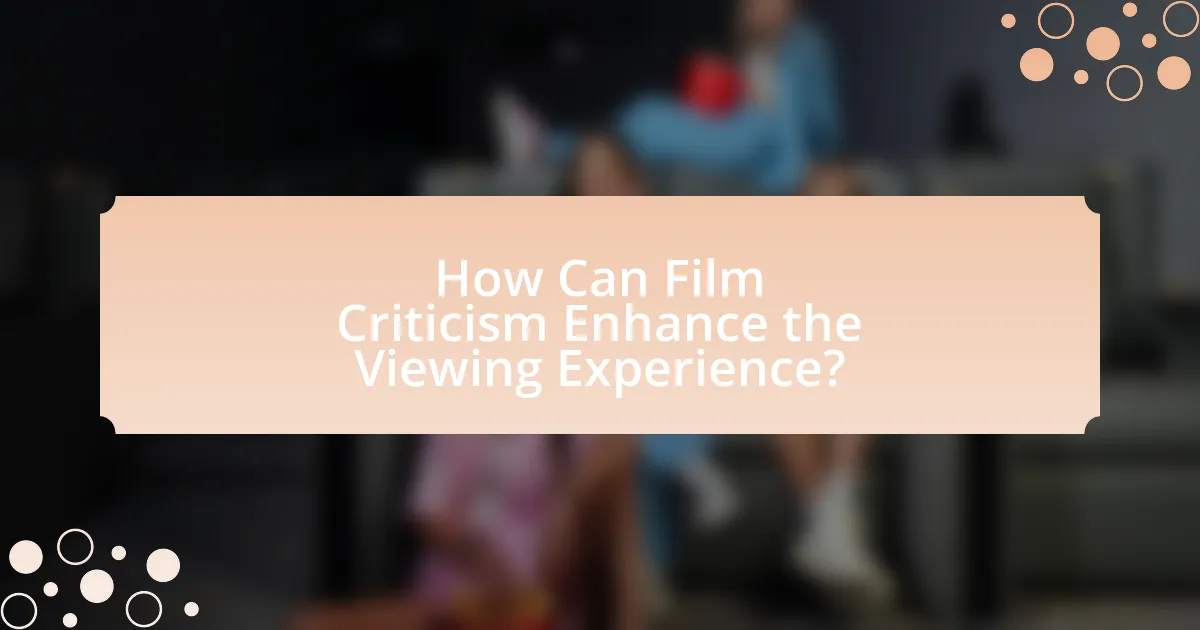Film criticism is a vital aspect of the cinematic landscape, providing analysis and evaluation that enhances audience understanding and appreciation of films. This article explores the significance of film criticism within the industry, highlighting its influence on audience perceptions, filmmakers’ careers, and cultural discourse. It examines various methodologies employed by critics, the challenges they face in the digital age, and the ethical dilemmas inherent in their reviews. Additionally, the article discusses how film criticism can enrich the viewing experience by offering insights into themes, narratives, and cinematic techniques, ultimately fostering a deeper engagement with the art of film.

What is the Importance of Film Criticism?
Film criticism is important because it provides analysis and evaluation of films, helping audiences understand and appreciate cinematic art. Critics offer insights into themes, techniques, and cultural contexts, which can enhance viewers’ experiences and foster deeper discussions about the medium. For instance, a study by the University of Southern California found that films receiving critical acclaim often perform better at the box office, indicating that criticism can influence audience choices and perceptions. Additionally, film criticism serves as a historical record, documenting the evolution of cinema and its societal impact, thus contributing to the broader discourse on art and culture.
Why is film criticism essential in the film industry?
Film criticism is essential in the film industry because it provides valuable insights that influence audience perception and industry standards. Critics analyze films, highlighting strengths and weaknesses, which helps filmmakers understand audience expectations and improve future projects. For instance, a study by the University of Southern California found that films receiving positive critical reviews tend to perform better at the box office, demonstrating the impact of criticism on commercial success. Additionally, film criticism fosters a dialogue about artistic merit and cultural significance, shaping the evolution of cinema as an art form.
How does film criticism influence audience perceptions?
Film criticism significantly influences audience perceptions by shaping their understanding and expectations of films. Critics provide analysis and context that can enhance viewers’ appreciation of cinematic elements such as storytelling, direction, and performance. For instance, a study published in the Journal of Communication found that positive reviews can increase a film’s box office performance by up to 20%, indicating that critics’ opinions can sway audience interest and attendance. Additionally, film criticism often highlights themes and social issues within films, guiding audiences to interpret and engage with the content on a deeper level. This interplay between criticism and audience perception underscores the critical role that film critics play in the film industry.
What role does film criticism play in shaping filmmakers’ careers?
Film criticism plays a significant role in shaping filmmakers’ careers by influencing public perception and industry recognition. Positive reviews can enhance a filmmaker’s reputation, leading to increased funding opportunities and collaborations, while negative critiques can hinder their prospects and limit distribution options. For instance, films that receive accolades from critics often perform better at the box office and gain awards recognition, which can elevate a filmmaker’s status in the industry. Historical examples include the impact of Roger Ebert’s reviews, which could propel a film’s success or failure, demonstrating the tangible effects of critical reception on a filmmaker’s trajectory.
How does film criticism contribute to cultural discourse?
Film criticism contributes to cultural discourse by providing analytical perspectives that shape public understanding of films and their societal implications. Critics evaluate themes, narratives, and character representations, which can influence audience perceptions and discussions about cultural issues such as identity, politics, and social justice. For instance, the critical reception of films like “Get Out” has sparked conversations about race relations in America, demonstrating how film analysis can reflect and challenge societal norms. This engagement fosters a deeper dialogue within communities, encouraging viewers to reflect on their values and beliefs in relation to the media they consume.
In what ways does film criticism reflect societal values?
Film criticism reflects societal values by analyzing and interpreting films through the lens of cultural, social, and political contexts. Critics often highlight themes such as gender roles, race relations, and class struggles, which mirror the prevailing attitudes and concerns of society at a given time. For instance, the rise of feminist film criticism in the 1970s emphasized the representation of women in cinema, aligning with the broader women’s rights movement. Additionally, critiques of films like “Get Out” have underscored racial tensions in America, showcasing how film can serve as a commentary on societal issues. This interplay between film and societal values illustrates how criticism not only evaluates artistic merit but also engages with the cultural zeitgeist, making it a vital tool for understanding societal dynamics.
How can film criticism foster discussions about diversity and representation?
Film criticism can foster discussions about diversity and representation by analyzing and highlighting the portrayal of marginalized groups in films. Critics can draw attention to the significance of authentic representation, which can influence audience perceptions and industry practices. For instance, studies have shown that films with diverse casts and narratives can lead to increased box office success, as seen with movies like “Black Panther,” which grossed over $1.3 billion globally and showcased a predominantly Black cast. By critiquing films through the lens of diversity, critics encourage filmmakers to create more inclusive stories, thereby promoting broader societal conversations about representation in media.

What are the Different Perspectives of Film Critics?
Film critics offer various perspectives that can be categorized into several key areas: artistic evaluation, cultural context, audience reception, and industry analysis. Artistic evaluation focuses on the film’s narrative structure, cinematography, and performances, assessing how these elements contribute to the overall artistic merit. Cultural context examines how films reflect or challenge societal norms, values, and historical moments, providing insights into the cultural significance of the work. Audience reception analyzes how different demographics perceive and respond to films, often highlighting the emotional and psychological impact on viewers. Industry analysis critiques the business aspects of filmmaking, including marketing strategies, box office performance, and the influence of studios on creative decisions. Each perspective contributes to a comprehensive understanding of a film’s impact and relevance in both the artistic and commercial landscape.
How do various film critics approach their craft?
Various film critics approach their craft through distinct methodologies that reflect their individual perspectives and expertise. Critics often analyze films based on narrative structure, cinematography, acting performances, and thematic depth, employing a combination of subjective interpretation and objective assessment. For instance, some critics prioritize emotional resonance and audience engagement, while others focus on technical aspects such as editing and sound design. This diversity in approach is evident in the work of prominent critics like Roger Ebert, who emphasized personal connection to the film, and Pauline Kael, who championed bold, provocative opinions. Their differing styles illustrate how critics can shape public discourse around cinema, influencing both audience perceptions and industry standards.
What methodologies do critics use to analyze films?
Critics use various methodologies to analyze films, including formalist, historical, ideological, and psychoanalytic approaches. The formalist methodology focuses on the technical aspects of film, such as cinematography, editing, and sound, to understand how these elements contribute to the overall meaning and aesthetic experience. Historical analysis examines the context in which a film was made, considering factors like the socio-political environment and the filmmaker’s background. Ideological criticism explores the underlying messages and values presented in a film, often relating them to broader cultural or political themes. Psychoanalytic criticism applies theories from psychology to interpret characters’ motivations and audience reactions. Each of these methodologies provides a distinct lens through which critics can evaluate and interpret films, enhancing the understanding of cinematic art.
How do personal experiences shape a critic’s perspective?
Personal experiences significantly shape a critic’s perspective by influencing their interpretations and emotional responses to films. Critics draw upon their unique backgrounds, including cultural, social, and personal histories, which inform their understanding of themes, characters, and narratives. For instance, a critic who has experienced loss may resonate more deeply with films exploring grief, leading to a more empathetic analysis. Research indicates that individual experiences can create biases that affect critical judgment, as seen in studies on how personal identity influences media consumption and interpretation. This interplay between personal experience and critical perspective underscores the subjective nature of film criticism.
What are the challenges faced by film critics today?
Film critics today face several significant challenges, including the rise of social media, which has democratized film commentary but also led to an overwhelming amount of unfiltered opinions. This shift has made it difficult for traditional critics to maintain authority and relevance in the industry. Additionally, the decline of print media has reduced job opportunities and financial stability for critics, as many publications have cut back on film coverage. The increasing influence of algorithms on content visibility further complicates their role, as critics must navigate platforms that prioritize engagement over quality analysis. These challenges highlight the evolving landscape of film criticism, where established voices struggle to adapt to rapid changes in technology and audience expectations.
How has the rise of social media impacted traditional film criticism?
The rise of social media has significantly transformed traditional film criticism by democratizing the platform for reviews and opinions. Social media allows a broader range of voices, including amateur critics and audiences, to share their perspectives instantly, which contrasts with the previously gatekept realm of professional critics. This shift has led to a more diverse array of opinions influencing public perception, as evidenced by the fact that platforms like Twitter and Instagram can generate viral discussions around films, impacting box office performance and critical reception. Additionally, traditional critics now often engage with social media to reach wider audiences, adapting their methods to include online interactions and real-time feedback, which has altered the dynamics of how film criticism is consumed and valued.
What ethical dilemmas do film critics encounter in their reviews?
Film critics encounter several ethical dilemmas in their reviews, primarily revolving around conflicts of interest, bias, and the impact of their opinions on the film industry. Critics may face conflicts of interest when they have personal relationships with filmmakers or studios, which can compromise their objectivity. Additionally, bias can arise from personal preferences or cultural backgrounds, potentially skewing their evaluations. The influence of a critic’s review can significantly affect a film’s success, raising ethical concerns about the responsibility they hold in shaping public perception and the careers of those involved in the film. For instance, a negative review can lead to financial losses for a film, impacting not just the filmmakers but also the wider industry ecosystem.

How Can Film Criticism Enhance the Viewing Experience?
Film criticism enhances the viewing experience by providing deeper insights into a film’s themes, techniques, and cultural context. Critics analyze elements such as cinematography, narrative structure, and character development, which can lead viewers to appreciate nuances they might otherwise overlook. For instance, a study by the University of Southern California found that audiences exposed to critical analysis reported a 30% increase in their understanding of a film’s underlying messages. This enriched comprehension fosters a more engaging and thought-provoking viewing experience, allowing audiences to connect more profoundly with the film’s artistic intentions.
What insights can film criticism provide to audiences?
Film criticism provides audiences with analytical insights that enhance their understanding of cinematic works. By evaluating elements such as narrative structure, character development, and thematic depth, critics help viewers appreciate the artistic intentions behind films. For instance, a review may highlight how a director’s unique style influences storytelling, allowing audiences to recognize subtleties they might otherwise overlook. Additionally, film criticism often contextualizes films within cultural and historical frameworks, enabling viewers to grasp broader societal implications. This critical perspective fosters a more informed viewing experience, encouraging audiences to engage with films on a deeper level.
How can critics help viewers appreciate cinematic techniques?
Critics can help viewers appreciate cinematic techniques by analyzing and articulating the elements of film such as cinematography, editing, sound design, and narrative structure. Through detailed reviews and discussions, critics highlight how these techniques contribute to storytelling and emotional impact. For instance, a critic may explain how the use of lighting in a scene enhances mood or how editing choices create tension, thereby deepening the viewer’s understanding and appreciation of the film’s artistry. This analytical approach not only educates audiences but also encourages them to engage more critically with films, fostering a greater appreciation for the craft involved in filmmaking.
What value does film criticism add to the understanding of themes and narratives?
Film criticism enhances the understanding of themes and narratives by providing analytical insights that dissect and interpret cinematic elements. Critics examine various aspects such as character development, plot structure, and visual symbolism, which helps audiences grasp deeper meanings and contextual relevance. For instance, a critic may highlight how a film’s use of color reflects emotional states or societal issues, thereby enriching the viewer’s comprehension of the narrative’s underlying messages. This analytical approach not only fosters a more profound appreciation of the film but also encourages discussions that can lead to diverse interpretations, ultimately broadening the audience’s perspective on the themes presented.
What are best practices for engaging with film criticism?
Best practices for engaging with film criticism include actively reading diverse critiques, participating in discussions, and reflecting on personal interpretations. Engaging with various perspectives enhances understanding of cinematic techniques and themes, as critics often analyze elements such as direction, cinematography, and narrative structure. For instance, reading critiques from established sources like Roger Ebert or The New York Times can provide insights into industry standards and audience expectations. Additionally, participating in forums or social media discussions allows for the exchange of ideas and fosters a deeper appreciation of films. Reflecting on personal views in relation to critics’ opinions can also lead to a more nuanced understanding of film as an art form.
How can viewers discern credible film critics from less reliable sources?
Viewers can discern credible film critics from less reliable sources by evaluating their credentials, consistency, and the platforms they use. Credible critics often have formal training in film studies or journalism, a history of published reviews, and a presence in reputable publications or platforms. For instance, critics associated with established outlets like The New York Times or Variety typically have a track record of professional experience and expertise. Additionally, consistent critical analysis and a well-defined perspective on films can indicate reliability, as these critics demonstrate a depth of understanding and a commitment to their craft.
What strategies can audiences use to deepen their understanding of films through criticism?
Audiences can deepen their understanding of films through criticism by actively engaging with various critical perspectives and analyses. This engagement can include reading reviews from established critics, participating in discussions or forums, and exploring academic essays that analyze film techniques, themes, and cultural contexts. For instance, studies have shown that audiences who read multiple reviews often develop a more nuanced understanding of a film’s narrative and artistic choices, as they are exposed to diverse viewpoints and interpretations. Additionally, attending film festivals or lectures where critics discuss their insights can further enhance comprehension by providing context and expert analysis.